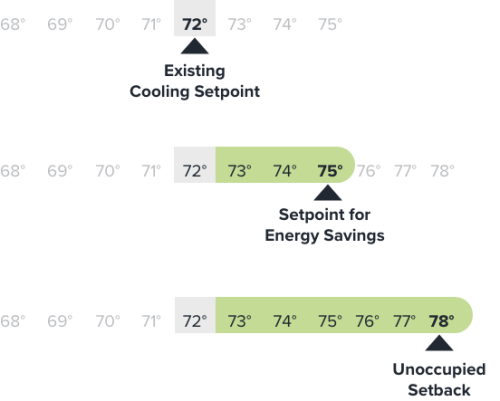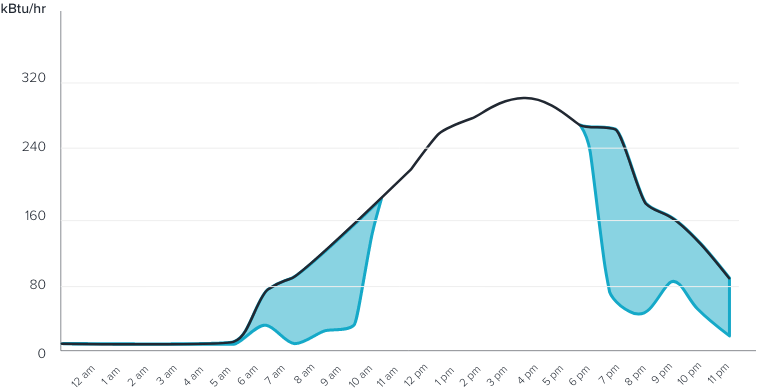How do we save energy on campus?
Adjusting Cooling Set Points and Schedules to Match Building Occupancy

When an HVAC system has to cool a building or zone to 72°F, the cooling system will be running almost continuously. If the set point is raised from 72°F to 75°F, the indoor temperature will be a little warmer, but the HVAC system won’t have to work as hard or continuously cool the building. Even more energy savings are possible when the set points change according to occupancy, called an unoccupied setback. Energy can be saved when spaces are not actively cooling when no one is there.
Historically, HVAC schedules on campus were set to avoid complaints from occupants - which often meant that systems would run late into the nights and on weekends. To reduce the energy wasted by conditioning empty spaces, our team is working with individual buildings to match HVAC schedules to the actual occupancy patterns and provide flexibility to after-hours occupants through local buttons.
Scheduling the HVAC systems is a great strategy for office, classroom, and community buildings. These buildings have similar heating and cooling needs and their patterns of occupancy lend themselves to turning down at night, on weekends, during national holidays, and also during intersession periods.
What Would These Energy Savings Look Like?
Cooling
Matching the HVAC system to building occupancy means not cooling the building after the building is empty. For example, to taper the cooling of a building starting at 6pm instead of 9pm when possible.
Chilled water use is typically the highest in the afternoon when it's hotter outside. Another opportunity to save cooling energy is to use outside air for cooling in the morning instead of chilled water. A strategy for this is called economizing.

Heating
A technique to achieve savings in heating energy is to time the heating of the building with the occupancy in the building. If people arrive at 8am, the heating may need to start around 6am or 7am for the building to be a comfortable temperature at 8am. Energy can be saved if our team has accurate information on building occupancy.
Heating in the afternoon, when it’s the warmest outside, is likely due to the overcooling of some spaces, leaving the spaces to be re-warmed.

Types of Scheduling
HVAC Scheduling for Events
The Energy & Engineering team identifies many buildings with Heating, Ventilation, and Air Conditioning (HVAC) schedules that don't match their real-life occupancy patterns. HVAC systems can be running on weekends and into late hours on weeknights, even though buildings are mostly vacant at these times. Nico Fauchier-Magnan, the Energy Engineer Supervisor summarizes, "There's a lot we can do across campus by catching the small issues that no one ever noticed but are still wasting energy."
In the 2018-19 fiscal year, the team adjusted HVAC schedules for almost 30 buildings, working closely with building managers and stakeholders to clearly determine the needs of the occupants, and to guarantee that the new schedules support the University’s mission.
HVAC Scheduling for Holidays
We are proactive in reducing energy waste on holidays. By leveraging the campus’s complex digital building control system, our engineers implement special holiday schedules and temperature set points for building heating, ventilation and air conditioning (HVAC) systems. The result is more HVAC systems are given a holiday too, and room temperatures are allowed to drift. These holiday savings and setbacks only affect administrative and classroom spaces and exclude laboratory and animal spaces.
During the holidays, some buildings are left completely vacant, which means they don't need their temperatures controlled as tightly. Therefore, temperature settings in these buildings are relaxed significantly during the holidays. The HVAC system will kick on if it gets too hot or too cold (say, above 85-90°F, or below 55-60°F). This is to both "protect" the building and prevent building temperatures from drifting too cold or hot in case someone shows up during the holiday. The relaxed temperature settings also prevent long warm-up or cool-down times after the holidays, e.g. shortening the time for a building to return to normal operations after the holidays.
You wouldn’t leave your home’s heating or cooling systems on while you go on vacation. It would continue to run as scheduled and be an utter energy waste.
Sam Cole, Energy Project Engineer
The week(s) in between academic quarters, or intersession periods, have potential for energy savings too. Intersession shutdowns occur during times of the year when some of our buildings get their very own winter, spring, and summer breaks.
Many buildings are unused in between academic terms or have shorter operating hours, and we take advantage of that by adjusting our HVAC systems accordingly and letting them get a bit of rest after a quarter of hard work. This includes portions of our libraries, our lecture halls, and our classroom spaces.